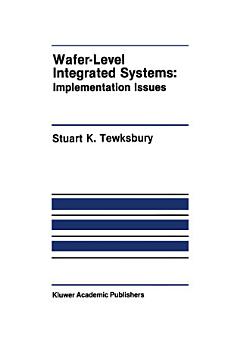Wafer-Level Integrated Systems: Implementation Issues
gru 2012 · The Springer International Series in Engineering and Computer Science Część 70 · Springer Science & Business Media
5,0star
2 opiniereport
E-book
456
Strony
reportOceny i opinie nie są weryfikowane. Więcej informacji
Informacje o e-booku
From the perspective of complex systems, conventional Ie's can be regarded as "discrete" devices interconnected according to system design objectives imposed at the circuit board level and higher levels in the system implementation hierarchy. However, silicon monolithic circuits have progressed to such complex functions that a transition from a philosophy of integrated circuits (Ie's) to one of integrated sys tems is necessary. Wafer-scale integration has played an important role over the past few years in highlighting the system level issues which will most significantly impact the implementation of complex monolithic systems and system components. Rather than being a revolutionary approach, wafer-scale integration will evolve naturally from VLSI as defect avoidance, fault tolerance and testing are introduced into VLSI circuits. Successful introduction of defect avoidance, for example, relaxes limits imposed by yield and cost on Ie dimensions, allowing the monolithic circuit's area to be chosen according to the natural partitioning of a system into individual functions rather than imposing area limits due to defect densities. The term "wafer level" is perhaps more appropriate than "wafer-scale". A "wafer-level" monolithic system component may have dimensions ranging from conventional yield-limited Ie dimensions to full wafer dimensions. In this sense, "wafer-scale" merely represents the obvious upper practical limit imposed by wafer sizes on the area of monolithic circuits. The transition to monolithic, wafer-level integrated systems will require a mapping of the full range of system design issues onto the design of monolithic circuit.
Oceny i opinie
5,0
2 opinie
Oceń tego e-booka
Podziel się z nami swoją opinią.
Informacje o czytaniu
Smartfony i tablety
Zainstaluj aplikację Książki Google Play na Androida i iPada/iPhone'a. Synchronizuje się ona automatycznie z kontem i pozwala na czytanie w dowolnym miejscu, w trybie online i offline.
Laptopy i komputery
Audiobooków kupionych w Google Play możesz słuchać w przeglądarce internetowej na komputerze.
Czytniki e-booków i inne urządzenia
Aby czytać na e-papierze, na czytnikach takich jak Kobo, musisz pobrać plik i przesłać go na swoje urządzenie. Aby przesłać pliki na obsługiwany czytnik, postępuj zgodnie ze szczegółowymi instrukcjami z Centrum pomocy.









